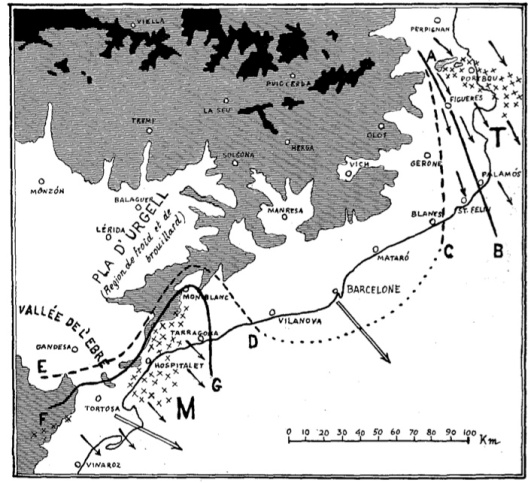Despite the fact that my job is all about the atmosphere, the one thing that is guaranteed to ruin my day is wind. Not passing wind, that’s hilarious, but unrelenting, tree-bending, dust-blowing, hair-mussing wind that come from air migrating from one spot to another.

In Catalonia, this is hatred is proving to be unfortunate. Wind is a defining feature of the climate here, particularly during winter and the transition to spring. During this time of year, a high pressure system often sets itself up to the west of Spain, and an opposing low pressure system plonks itself to the east of the UK.
Like a marble at the top of a hill, air naturally wants to go from the high to the low, but the rotation of the Earth pushes it off course, and cold air is channeled from the north across southern France and northern Spain.
According to this amazing-looking paper from 1949, the ‘great atmospheric current’ created by these systems is split in Spain by the Pyrenees, and forms the tramontane and mistral (or tramontana and mestral in Catalan).

In the north near Girona (Dali’s ‘hood), the bitterly cold tramontana wind races across the Pyrenees. People who live there are known to be ‘tocats per al vent‘, or mentally ‘touched’ by the wind. As I raged my way to work this morning against the wind I could kind of understand why the murder and suicide rates go up in the region if the tramontana blows for more than 10 days.
Around Tortosa, the furious northwest mestral wind races along the Ebro River, funneled by the mountains on either side. This week we’ve had four days of 35–50 km an hour winds, with gusts up to 107 km/hr. My colleagues tell me that people from around here are also considered kind of strange (and loud!) because of the wind.

A distinctive cloud forms over the nearby Ports when the mestral is a’blowin called la cella, or ‘the eyebrow’. As you can see, it is a pretty apt description.

There are also some amazing orographic clouds (clouds that form when air flows over a mountain) that have formed every day this week, making for some impressive sunsets. Not that I can see them from all the dust in my eyes!

Dear Dr. Ashcroft,
I have read with great interest your thesis work on the climate of South East Australia before 1910, which I’m attempting to reproduce, at least in part, and am putting all the gory details in the following blog:
https://climanrecon.wordpress.com/
I would welcome any comments you have on my results and conclusions, and any information you can give on what happened when you passed your step change info to Blair Trewin. I would like to add a blog post on existing “early” climate reconstructions, would you be interested in writing such an article?
LikeLike
Dear Linden,
What an apt and timely post on the pesky winds of coastal Catalonia! As I write, the wind is howling around our flat, which we rented while we observe and occasionally supervise the leisurely progress of the renovation works going on in the house that we purchased a year or so ago, here in Sant Carles de la Rapita.
I’m no meteorologist (actually I’m a semi-retired geophysicist), but I have hung around in boats a little and I would say that right now it’s a-blowin’ force 7-8 or more out there (Beaufort scale indications – local seafront restaurants hastily close their shutters again, having opened for the new season somewhat over optimistically in last week’s sunshine, The local dog population are thankfully silenced as it’s too unpleasant to go out and yap at passing pedestrians).
Last winter, I remember being woken up by the noise of the wind and looking out to see the whole of Alfacs bay enshrouded in a strange, white, low level mist, caused by spray torn from the wave tops by the offshore wind, although the waves themselves were quite small, due to the short “fetch”, and scarcely visible from land, .
Coming, as I do, from the flat expanses of the fen country in East Anglia, I’m no stranger to wind, There, they do say that them thar ole North East winds blow straight from Siberia,with nuthin’ in between to stop ’em. But I have to say that I’m impressed with the relentless nature of the wind in these parts. As winds go, it’s not especially cold, but golly, does it mean business as it rattles the shutters, blows small branches of the palm trees and insinuates itself down the cooker hood vent!
I’m just glad to know that the causes and effects of these winds are being investigated with such erudition and good humour by you and your colleagues in Tortosa.
with kind regards,
Charlie Hewlett
LikeLike
Hi Charlie,
Many thanks for your comments! I really appreciate them. I too am impressed by the determination of the wind in these parts.
If you are a fan of Beaufort and his mighty scale, you might be interested in Scott Huler’s book on the topic (if you don’t know it already). I read it over Christmas and it has given me a new appreciation for the mestral: http://sciencebookaday.com/2016/02/04/linden-ashcroft-reviews-defining-the-wind-the-beaufort-scale-and-how-a-19th-century-admiral-turned-science-into-poetry/
Best of luck with the renovations,
Linden
LikeLike